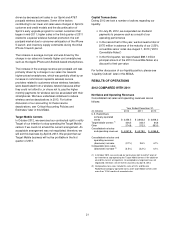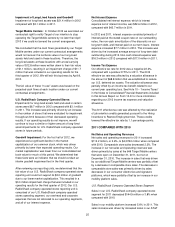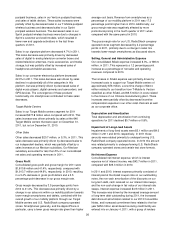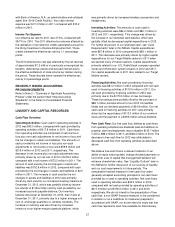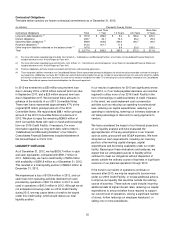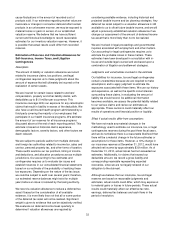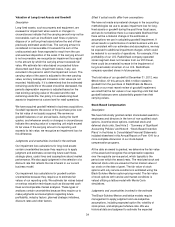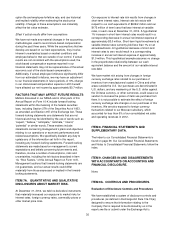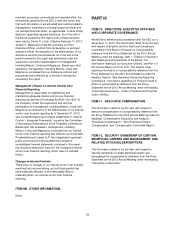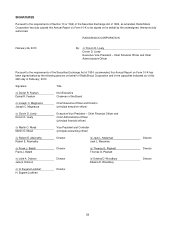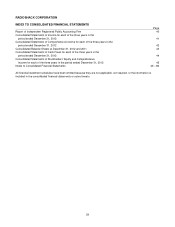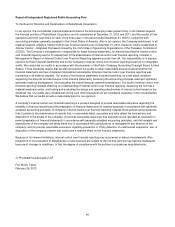Radio Shack 2012 Annual Report Download - page 33
Download and view the complete annual report
Please find page 33 of the 2012 Radio Shack annual report below. You can navigate through the pages in the report by either clicking on the pages listed below, or by using the keyword search tool below to find specific information within the annual report.
31
Capitalization
The declaration of dividends, the dividend rate, and the
amount and timing of share repurchases are at the sole
discretion of our Board of Directors, and plans for future
dividends and share repurchases may be revised by the
Board of Directors at any time.
The following table sets forth information about our
capitalization on the dates indicated.
December 31,
2012 2011
(Dollars in millions)
Dollars
% of Total
Capitalization
Dollars
% of Total
Capitalization
Short-term debt $ 278.7
20.2% $ -- 0.0%
Long-term debt 499.0
36.3 670.6
47.1
Total debt 777.7
56.5 670.6
47.1
Stockholders’
equity
598.7
43.5
753.3
52.9
Total capitalization
$1,376.4
100.0% $1,423.9
100.0%
Our debt-to-total capitalization ratio increased in 2012 from
2011, primarily due to the $175.0 million of new borrowings
under the secured term loans due in 2016 and 2017. These
borrowings were partially offset by purchase of $88.1
million principal amount of the 2013 Convertible Notes.
Dividends: We paid $0.125 per share dividends in the first
and second quarters of 2012. On July 25, 2012, we
announced that we were suspending our dividend. We paid
per share annual dividends of $0.50 and $0.25 in 2011 and
2010, respectively. Our dividend payments totaled $24.9
million, $49.6 million, and $26.5 million in 2012, 2011 and
2010, respectively, and were funded from cash on hand.
2011 Share Repurchase Program: In October 2011 our
Board of Directors approved a share repurchase program
with no expiration date authorizing management to
repurchase up to $200 million of our common stock to be
executed through open market or private transactions.
During the fourth quarter of 2011, we paid $11.9 million to
purchase approximately 0.9 million shares of our common
stock in open market purchases. As of December 31, 2011,
there was $188.1 million available for share repurchases
under this program. We announced on January 30, 2012,
that we had suspended further share repurchases under
this program.
2008 Share Repurchase Program: In November 2010 we
completed a $300 million accelerated share repurchase
(“ASR”) program that we entered into in August 2010. We
repurchased 14.9 million shares under the ASR program. In
addition, after the conclusion of the ASR program in
November 2010, we repurchased $98.6 million worth of
shares in the open market, representing 4.9 million shares.
During the second quarter of 2011, we paid $101.4 million
to purchase 6.3 million shares of our common stock in open
market purchases. This completed our purchases under our
2008 share repurchase program.
OFF-BALANCE SHEET ARRANGEMENTS
Other than the operating leases described above, we do
not have any off-balance sheet financing arrangements,
transactions, or special purpose entities.
INFLATION
Inflation has not significantly affected us over the past three
years. We do not expect inflation to have a significant effect
on our operations in the foreseeable future.
CRITICAL ACCOUNTING POLICIES AND
ESTIMATES
Our consolidated financial statements are prepared in
accordance with generally accepted accounting principles
(“GAAP”) in the United States. The application of GAAP
requires us to make estimates and assumptions that affect
the reported values of assets and liabilities at the date of
the financial statements, the reported amount of revenues
and expenses during the reporting period, and the related
disclosures of contingent assets and liabilities. The use of
estimates is pervasive throughout our financial statements
and is affected by management’s judgment and
uncertainties. Our estimates, assumptions and judgments
are based on historical experience, current market trends
and other factors that we believe to be relevant and
reasonable at the time the consolidated financial
statements are prepared. We continually evaluate the
information used to make these estimates as our business
and the economic environment change. Actual results may
differ materially from these estimates under different
assumptions or conditions.
In the Notes to Consolidated Financial Statements, we
describe the significant accounting policies used in the
preparation of our consolidated financial statements. The
accounting policies and estimates we consider most critical
are revenue recognition; inventory valuation; estimation of
reserves and valuation allowances specifically related to
insurance, tax and legal contingencies; valuation of long-
lived assets and goodwill; and stock-based compensation.
We consider an accounting policy or estimate to be critical
if it requires difficult, subjective or complex judgments, and
is material to the portrayal of our financial condition,
changes in financial condition or results of operations. The
selection, application and disclosure of our critical
accounting policies and estimates have been reviewed by
the Audit and Compliance Committee of our Board of
Directors.


